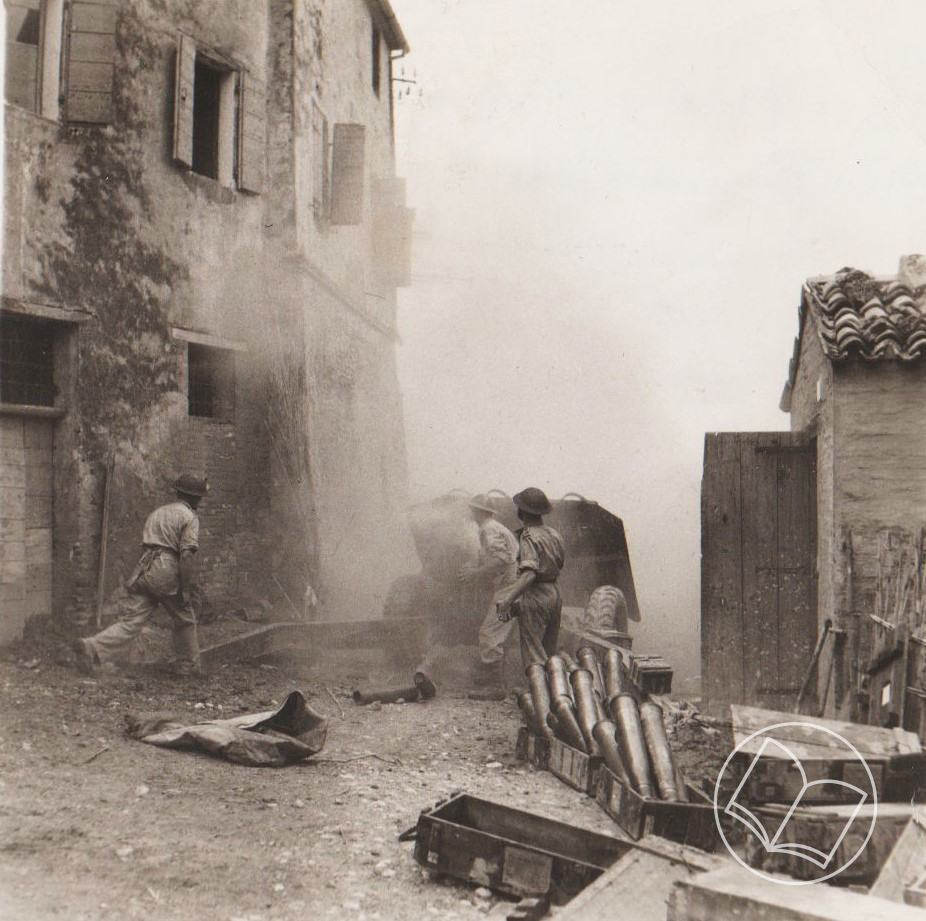


A Black Cat Abroad, A Territorial Gunner’s Selected Memories of World War II and the Italian Campaign (1943-1945)


R.E.H. at Tilshead Camp, August 1939. Image courtesy of REH Hadingham Collection.
By R.E.H. Hadingham C.B.E. M.C. and Bar. Edited by Steffie Shields M.B.E.
Reginald Edward Hawke Hadingham, nicknamed ‘Oscar’ and better known as ‘Buzzer’, played a central role in the life of the 67th (East Surrey) Anti-Tank Regiment, Royal Artillery, TA, serving continuously from its formation through to the end of the war, and winning a Military Cross and Bar in the process.
The book, edited by R.E.H’s younger daughter Steffie Shields, is presented in two parts. The first reproduces her father’s Diary 1939, only discovered after his death in December 2004, aged 89 years. Written in three leather-bound notebooks, the diary chronicles the months leading up to the outbreak of the war. The second part, Selected Memories of War, dates back to 1981 following an approach by the Imperial War Museum for his wartime recollections. As a result, and encouraged by his elder daughter Susan Diedrick, over the next year or so, R.E.H. drafted a manuscript, which she then typed up, but it remained unpublished.
It was during the Covid Pandemic Lockdown 2020/21, that Steffie decided to bring the two parts together, collating the diary and memoir with ephemera from his collection – reports, news cuttings, photographs, various poems and private letters to produce an online publication primarily for family reference. As this progressed, she came to recognise that the unique collective significance of the diary together with his memoir might be worthy of a wider readership of military history.
R.E.H. was motivated to start writing his Diary 1939 in the belief that the coming year was likely to be an historic one and the entries provide a running commentary on and impressions of the defining events on the seemingly inevitable road to war. He also chronicles his employment as the export manager for the Slazenger sporting goods company and his social life, centred on the courtship of his future wife Lois, accompanied by numerous games of bridge. In February a new dimension is added with his enlistment as a gunner in the 57th (East Surrey) Anti-Tank Regiment, RA, TA at Wimbledon. The Diary details evenings spent training at the drill hall in St George’s Road. Assigned to E Troop, 226 Battery, R.E.H. is given the key role as the layer (responsible for firing the gun) in a 2-pounder anti-tank gun team and he gives a particularly good outline of the drill to bring the gun in and out of action, together with other parades and lectures.
Feeling progressively out of place among his fellow gunners, however, R.E.H. sets out to secure a commission and following a series of interviews and medicals, he was gazetted in June as a 2nd Lieutenant in the 67th Anti-Tank Regiment, RA, TA. This was the second line regiment formed the same month on the doubling up of the Territorial Army, with men transferred from the 57th and new recruits, who were in the majority. R.E.H. was posted to 265 Battery at Streatham and with the intensive training activities that summer, including attending a two week Annual Camp at Tilshead, the Diary was put on hold. Apart from the first five days of July it is then abandoned, but Steffie provides a brief outline of the years the Regiment spent in the UK on Home Defence. This includes the bombing of Detling Airfield in which 265 Battery suffered six fatalities and, nine months later, R.E.H. taking into captivity the five-man crew of a German Heinkel bomber which made a forced landing 70 yards from the Battery headquarters at Kennington, near Ashford.
In March 1942 R.E.H. was appointed Adjutant and in August embarked with the Regiment for overseas. On arrival of the convoy in Cape Town, he was promoted Major and given command of 302 Battery, a position he was to hold for the next three years.
Part Two of the book, Selected Memories of War, Italian Campaign (1943-45), is comprised of eight essays in which R.E.H. records his memories in what were effectively the key episodes and battles of the 67th Anti-Tank Regiment. The Regiment was in action throughout the Italian Campaign as part of the 56th (London) Infantry Division with 302 Battery in support of its 167th Infantry Brigade.
The first essay takes a step back to the end of the campaign in North Africa. This involved the Division in a long approach march by road from Kirkuk in Iraq to Enfidaville in Tunisia to join the 8th Army; some 3200 miles were covered in 28 days. On arrival on 26 April, the Regiment was warned to be ready to go into action, with G Troop, 302 Battery being the first to do so in support of an attack on some high ground called The Humps. As the commander of 302 Battery, R.E.H. followed the leading infantry company ready to call up at least a troop of 6-pounders to form a defensive screen against a tank counter-attack. With the eventual surrender of the Axis forces, R.E.H. also witnessed the remarkable sight of truckload after truckload of German troops driving themselves into captivity.
The second essay focuses on the invasion of the Italian mainland and the landing at Salerno on 9 September where the 56th Division was one of the two assaulting divisions in the British sector. R.E.H. was tasked with forming a screen on the right of the bridgehead, which involved co-ordinating the layout of no less than 54 anti-tank guns. Once ashore, he is to be found frequently in the forward area moving up and siting the Battery’s 6 and 17-pounder guns and is awarded a Military Cross for restoring a position after an enemy counter-attack. At 22 pages the essay is the longest and provides much useful information not found in the Regiment’s short history, ‘Right A-Half’, published in Italy at the end of the war, and the bald entries in the War Diary. A contemporary report written by R.E.H. on the anti-tank aspect of the landing which closes the essay similarly adds to the story.
The next two essays deal respectively with the crossing of the Volturno and Garigliano Rivers. As Steffie correctly identifies, R.E.H.’s memory failed him here in giving the dates of the latter as being on the night of 12/13 October. The attack actually took place in January 1944 with the War Diary stating that 302 Battery crossed the Garigliano at 4 a.m. on 18 January. The October dates were for the Volturno crossing. Dates aside, R.E.H. again provides lively accounts, particularly for the Garigliano, where in addition to seeing the guns forward, he was also asked to take command of a scratch infantry company and in one incident received the unwelcome attention of a German sniper. He also goes on to receive a Bar to his Military Cross in a firefight with a German Mark IV tank and a dozen German soldiers in the village of San Lorenzo, having gone forward with his Battery Sergeant Major to check on a Troop of 6-pounders in position there.
In February 1944, the Regiment was sent to the Anzio Bridgehead, which is the subject of the fifth essay. 302 Battery was the first to arrive and deployed on the lateral road running west from the prominent flyover bridge. The road was under constant enemy observation and any daytime movement attracted enemy shelling. R.E.H. records that the job he liked least of all the actions in which he had so far been involved, was driving up at last light to visit the guns on the road, bringing supplies to the crews. With both the Commanding Officer and Second In Command falling sick, he was later temporarily put in command of the Regiment.

Sgt Grinter's 17-pounder (H Troop, 302 Battery) firing from farm at Monte Fiore Conka. Image courtesy of REH Hadingham Collection.
After a three month spell in Egypt, where the Division had been sent to rest, refit and retrain, R.E.H., back with 302 Battery, was again in action in the assault on the Gothic Line on the Adriatic Coast. In this essay, one can detect war-weariness setting in with R.E.H. confessing it was a long, hard slog, battling on and on, pushing the Germans relentlessly back off one ridge after another and regularly coming under shell fire with the enemy always holding the higher ground. R.E.H. also witnesses closely the death of a fellow officer prompting reflection on not thinking of what may happen and as an officer the need to soldier on and try to set an example. The essay also includes some good photos of the Battery’s 17-pounder guns in action at Gemmano, which R.E.H. describes as one of the grimmest battles of all the Gothic Line actions.
After the heat and dust of the Gothic line, the final short essay San Marino and the Senio, finds R.E.H. wet, cold, homesick and war-weary. The essay is interesting however in highlighting a first experience of using radar.
The Selected Memories are followed by an Appendix of various letters, photos, poems, reports and printed ephemera that shed light on the remainder of R.E.H’s wartime experiences. They include a June 1945 farewell note to 302 Battery on being made Second in Command of the Regiment. Later R.E.H. would assume command of the Regiment prior to its amalgamation and disbandment, which he oversaw. This section also reproduces a detailed report, from an anti-tank perspective, on the practical experience of the Regiment throughout the Italian campaign. The remarks and suggestions in the report cover topics including organisation, personnel, transport, guns and ammunition, etc.
In a Postscript, Steffie relates briefly her father’s post-war family life and career as the chairman of Slazenger’s and then the All England Lawn Tennis Club, Wimbledon. This is supported by a number of interesting obituaries published in the main broadsheet newspapers.
Before a final poem on wartime separation, the book ends with an Afterthought written in 1946 musing about doing all that can be done to stop the next war and how things are allowed to drift until the next war descends upon us. R.E.H. relates, ‘Take my own case. I had my share of fighting this time. Many times, I vowed to myself, and I swore with all the other fellows, that it must never happen again…’ In light of the invasion of Ukraine and other conflicts around the globe, it is sad to report that this wish has not been, or may never, be fulfilled.
The book will be of great interest to those with a family connection to the men who served in the 67th Anti-Tank Regiment and also to all those with an interest in the anti-tank arm and the Italian Campaign. A Black Cat Abroad is published in a hardback of 304 pages by Uniform an imprint of the Unicorn Publishing Group, Lewes (ISBN 978-1-914414-63-3) at £25 and is highly recommended.